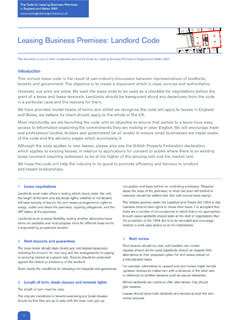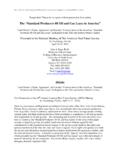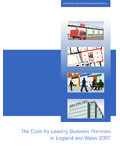Transcription of Your Lease - What does it all mean - Peter Dunn and Co
1 your Lease - what does it all mean? your Lease is a substantial document. what follows is an attempt to explain some of the standard terms of a Lease . It does not replace you reading it, in full, and satisfying yourself that you understand it and agree to each of the provisions. We will advise you separately of some of the ways in which your Lease may depart from the description here. You must ask if you have any doubts. your Lease may not include all these clauses, and they may not be in this order. This document is based upon a Code of Practice for Commercial Property Leases. Due acknowledgement is given. of the Lease Lease will usually be for a fixed number of years agreed by you. It will run from a date in the Lease which will not usually be the date the Lease is signed. to Break leases contain a clause (called a 'break clause') giving one or both parties a right to end the Lease before the end of the term. Break clauses are often limited to defined circumstances when the landlord wishes to redevelop, or after the outcome of a rent review.
2 The right to break is often conditional upon an absolutely strict performance of the obligations in the Lease . Break clauses have strict timetables for serving notices. There may also be penalties imposed for exercising the break. A landlord seeking to break a Lease may also have to comply with Part II of the Landlord and Tenant Act 1954. Lease will contain a clause allowing the landlord to repossess the property if the tenant is late paying the rent, or breaks any of his obligations or becomes insolvent. The operation of forfeiture clauses requires technical legal knowledge and should not be undertaken without professional advice. a landlord seeks forfeiture the tenant may seek to retain the property despite the breach. Tenants who are threatened with repossession or whose property is actually forfeited will need specialist advice if they wish to keep or regain possession. under the Landlord and Tenant Act 1954 Part II this Act business tenants are given some security, in the form of a new Lease at an appropriate rent to follow the current tenancy.
3 Landlord can sometimes oppose a new tenancy, for example, a history of non-payment of rent or other breach of obligation; the provision of alternative accommodation; redevelopment or substantial reconstruction; or the landlord's wish to carry on its own business in the property. Disputes about new tenancies that cannot be settled by agreement are referred to the Court, but the Court has power to refer the question to an 1 of 9arbitrator if the parties agree (High Court) or at the request of either party (County Court). parties can contract out of the provisions of the Act regarding security of tenure and rights of renewal with the Court's approval before the Lease is granted. on the workings of this Act is contained in the Office of the Deputy Prime Minister s 'Guide to the Landlord and Tenant Act 1954' ( ) Lease state will how much is payable, and when, and what might happen if payment is late, a high rate of interest may be charged or the Lease may be taken back or 'forfeited' a 'headline rent' is mentioned when discussing Lease terms.
4 This means the rent reserved in the Lease , but ignoring any incentives for the tenant such as rent free periods. Review normally contain detailed provisions for how the rent is to be reviewed. Generally these will not refer to the performance of the tenant's own business. The new rent is more likely to be the letting value of the property in the open market with vacant possession at the date of review. Although there are exceptions, the figure is normally arrived at by looking at recent open market lettings, rent reviews and Lease renewals of similar properties in the area let on similar terms. transactions are called 'comparables'. Appropriate adjustments are made to comparable rents to reflect the exact circumstances of the property or the Lease terms for which the review is being carried out. the rent should be agreed if possible, it is important to provide carefully in the Lease for how the rent will be decided if the parties cannot agree.
5 Solicitors and property advisers will advise on such questions as to whether the Lease should provide for an arbitrator to be appointed in the event of a disagreement, or an independent expert, or whether alternative dispute resolution procedures (ADR) should be considered (see section 16 below). following are examples of ways in which the rent can be revised: i.'Upward only' The rent cannot be reduced below the rent already being paid but either increases or stays the same depending, essentially, on how much the property could be let for at the date of review. This is commonly called an 'upward only' clause. 2 of base rent The rent cannot fall below the rent first payable at the beginning of the Lease but subject to that can go up or down depending on the market value at the time of the review. market value The rent goes up or down (or stays the same) depending only on the market value at the review date. rent A 'turnover rent' is normally either a combination of a base rent and an element reflecting the tenant's turnover, or a simple percentage of turnover.
6 Linked The rent is 'index linked', normally it changes from year to year in line with an agreed index such as the Retail Price Index. increases Here the Lease simply sets out when and by how much the rent will increase. all of these alternatives will be available in every case. Choices available will depend on the strength of the tenant's financial standing, the prevailing rental market, the length of Lease available and any other particular circumstances of landlord and tenant or the property. OR ADDITIONAL COSTS costs incurred by the owner ( for repairs, rates and insurance premiums) are usually charged to the tenant in addition to the principal rent, either individually or by way of a 'service charge', especially in a building in multiple occupation. leading property industry and professional bodies have agreed a Guide to Good Practice in relation to service charges which is available free standard of repair which has to be achieved is judged by the wording of the Lease , and the general age, condition, quality and location of the property.
7 More specific words 3 of 9like 'rebuild', 'renew' and 'replace' are sometimes used which may make the obligations more onerous. a tenant takes on an obligation to keep property in repair, that will include an obligation to remedy any disrepair existing at the beginning of the term as well as disrepair occurring while the Lease is running. There is often a requirement on the tenant to redecorate periodically inside and out. landlord may want to include a power to carry out the repairs at the tenant's cost if the tenant fails to do so. the tenant is required to carry out initial improvements and repairs there may be implications for tax and rent review, and professional advice should be sought. leases state who has to arrange insurance and who pays the premiums. A provision may be agreed which stops the insurance company from taking over the landlord's right to sue the tenant, where the tenant's negligence has caused the damage, by fire, and the insurance company has paid the claim.
8 The landlord insures, the Lease usually provides for payment of rent to cease ('abate') until the property has been reinstated after damage by insured risks. Sometimes the period of abatement is limited to the period for which the landlord is insured for loss of rent ( three years). should take out their own insurance against loss or damage to their contents as well as business insurance (loss of profits etc.) and any other consequential risks not covered by the landlord's policy. on the VAT status of the particular property, the tenant may be expected to pay VAT on rent and on costs incurred by the owner and charged to the tenant. A property which was originally not subject to VAT may become so for reasons beyond the tenant's control and professional advice may be needed. and Subletting (or Alienation) are two main ways in which the tenant may pass on the Lease obligations to a third party: a.'assignment' (selling, giving away or paying someone to take over the Lease ); b.
9 Subletting (remaining as tenant of the Lease with the Lease obligations, but granting a sublease to another tenant who undertakes the same or similar obligations). 4 of usually restrict to some extent the tenant's right to assign the Lease to a new tenant, or to grant a sublease or share the premises. The assignment of only part of the premises is usually absolutely prohibited. the Lease provides that the tenant has to obtain the landlord's consent to a transfer or a sub-letting. This consent will usually depend on the potential assignee passing some form of test by meeting certain conditions. In some cases the tests take the form of the landlord exercising a subjective judgement and in most of these cases the landlord's consent must not be unreasonably withheld and the landlord cannot demand money (apart from reasonable expenses) as a condition of granting it. In other cases the landlord will have set objective tests where the landlord has no discretion, the tests simply being met or not.
10 The reasonableness of these latter tests cannot be referred to the courts. the landlord wants to prohibit transfers, prospective tenants should think carefully before agreeing, as there will be no possibility of escaping from the obligations of the Lease throughout its term unless the landlord subsequently gives consent. of Premises leases restrict the use(s) to which the premises may be put but, if the landlord does not require a restriction, the tenant is free to use the premises in any lawful way. However, many tenants and landlords find that very restrictive clauses are not in their interests. The tenant often wants flexibility and will have trouble in transferring or subletting the premises to someone in another trade or profession if the range of permitted uses is too limited. Very restrictive clauses may not suit the landlord in many cases, because they may have a depressing effect on rent at review or when the Lease comes up for renewal.



